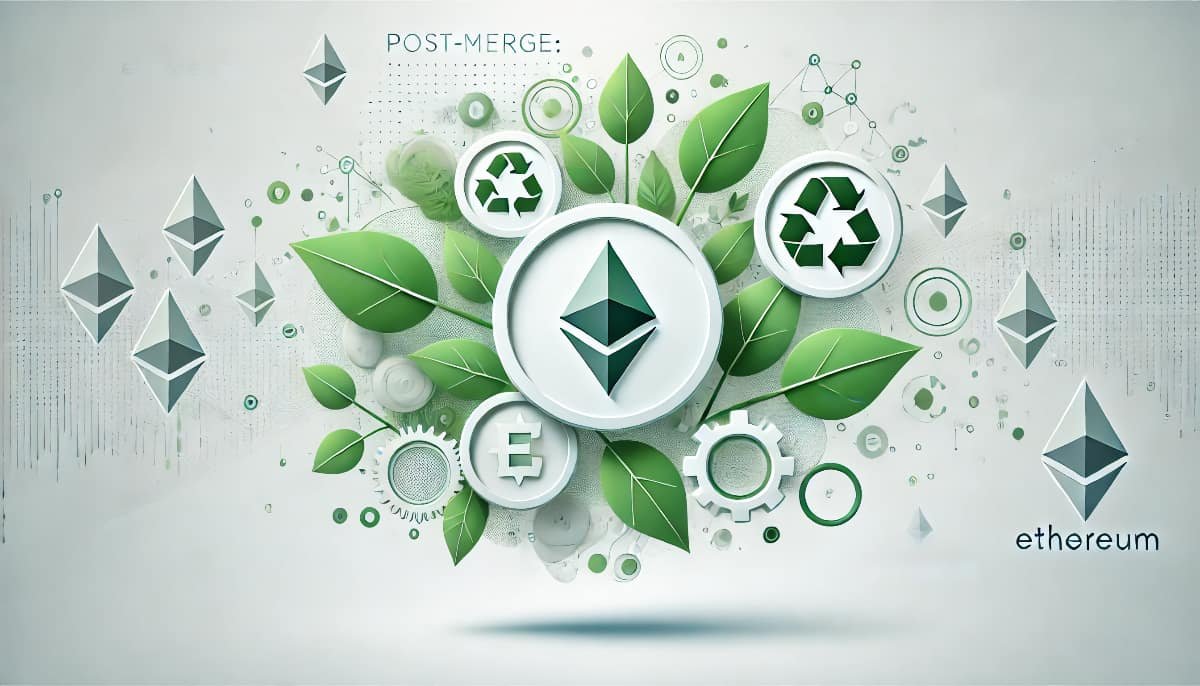The Evolution of Ethereum: From Proof of Work to Proof of Stake
Ethereum, the second-largest cryptocurrency by market capitalisation, has undergone a significant transformation with the completion of its long-anticipated upgrade known as “The Merge.” This upgrade marks Ethereum’s transition from a Proof of Work (PoW) consensus mechanism to a Proof of Stake (PoS) system. The shift aims to address several critical issues, including scalability, security, and, most importantly, environmental sustainability. But does this transition make Ethereum truly eco-friendly and sustainable? This article delves into the intricacies of Post-Merge Ethereum to answer this pressing question.
Video: What’s The ETH Merge?
Understanding Proof of Work (PoW)
Before diving into the specifics of Proof of Stake, it’s essential to understand the limitations of the Proof of Work mechanism that Ethereum previously employed.
How Proof of Work Operates
Proof of Work is a consensus algorithm used by many cryptocurrencies, including Bitcoin and, until recently, Ethereum. In this system, miners compete to solve complex mathematical puzzles to validate transactions and add them to the blockchain. The first miner to solve the puzzle gets to add the block and is rewarded with cryptocurrency.
- High Energy Consumption: The computational power required for mining is immense, leading to significant energy consumption.
- Hardware Requirements: Miners need specialised hardware, which can be expensive and resource-intensive to produce.
- Centralisation Risks: The high costs associated with mining can lead to centralisation, where only a few entities control the majority of the mining power.
Environmental Impact of Proof of Work
The environmental impact of PoW is a major concern. According to the Cambridge Bitcoin Electricity Consumption Index, Bitcoin mining alone consumes more electricity annually than some entire countries. Ethereum, while less energy-intensive than Bitcoin, still contributed significantly to this environmental burden.
The Shift to Proof of Stake (PoS)
The Merge represents Ethereum’s transition to a Proof of Stake consensus mechanism, which promises to be more energy-efficient and sustainable.
How Proof of Stake Works
In a PoS system, validators are chosen to create new blocks and validate transactions based on the number of coins they hold and are willing to “stake” as collateral. This eliminates the need for energy-intensive computations.
- Energy Efficiency: PoS drastically reduces the energy consumption required for network security.
- Lower Barriers to Entry: Validators do not need expensive hardware, making the system more accessible.
- Decentralisation: Lower costs can lead to a more decentralised network, as more participants can afford to become validators.
Environmental Benefits of Proof of Stake
The transition to PoS is expected to reduce Ethereum’s energy consumption by approximately 99.95%. This is a monumental shift that could make Ethereum one of the most eco-friendly blockchain networks in existence.
Comparing Energy Consumption: PoW vs PoS
To understand the environmental benefits of PoS, it’s helpful to compare the energy consumption of PoW and PoS systems.
| Consensus Mechanism | Energy Consumption (Annual) | Environmental Impact |
|---|---|---|
| Proof of Work (PoW) | ~110 TWh | High |
| Proof of Stake (PoS) | ~0.01 TWh | Low |
The table above illustrates the stark contrast in energy consumption between PoW and PoS. The reduction in energy usage is not just significant; it’s transformative.
Challenges and Criticisms of Proof of Stake
While PoS offers numerous benefits, it is not without its challenges and criticisms.
Security Concerns
One of the primary concerns is the security of PoS systems. Critics argue that PoS may be more vulnerable to certain types of attacks, such as the “Nothing at Stake” problem, where validators have no disincentive to validate multiple blockchain forks.
Wealth Centralisation
Another criticism is that PoS could lead to wealth centralisation. Since validators are chosen based on the number of coins they hold, those with more coins have a higher chance of being selected, potentially leading to a concentration of wealth and power.
Complexity and Implementation
The transition from PoW to PoS is a complex process that requires significant changes to the network’s infrastructure. This complexity can introduce new risks and challenges that need to be carefully managed.
Real-World Impact: Case Studies and Examples
To gauge the real-world impact of Ethereum’s transition to PoS, it’s useful to look at some case studies and examples.
Decentralised Finance (DeFi) Platforms
Many DeFi platforms operate on the Ethereum network. The shift to PoS has the potential to make these platforms more sustainable and cost-effective, as lower energy consumption translates to lower operational costs.
Non-Fungible Tokens (NFTs)
NFTs have gained immense popularity, but their environmental impact has been a point of contention. The transition to PoS could make NFT transactions more eco-friendly, addressing some of the criticisms levied against them.
Future Prospects: What Lies Ahead for Ethereum?
The Merge is just one step in Ethereum’s broader roadmap, which includes several other upgrades aimed at improving scalability, security, and sustainability.
Sharding
Sharding is a technique that involves splitting the blockchain into smaller, more manageable pieces called “shards.” This can significantly improve the network’s scalability and efficiency.
Layer 2 Solutions
Layer 2 solutions, such as rollups, aim to process transactions off the main Ethereum chain, further reducing the network’s energy consumption and improving scalability.
Continued Research and Development
The Ethereum community is continually researching and developing new technologies to enhance the network’s sustainability and performance. This ongoing innovation is crucial for maintaining Ethereum’s position as a leading blockchain platform.
Conclusion: Is Post-Merge Ethereum Eco-Friendly and Sustainable?
The transition to Proof of Stake represents a significant step forward in making Ethereum more eco-friendly and sustainable. By drastically reducing energy consumption, PoS addresses one of the most pressing criticisms of blockchain technology. However, it’s essential to acknowledge that PoS is not a panacea. It comes with its own set of challenges and criticisms that need to be carefully managed.
Overall, the Merge is a positive development for Ethereum and the broader blockchain ecosystem. It demonstrates a commitment to sustainability and innovation, setting a precedent for other blockchain networks to follow. As Ethereum continues to evolve, it will be crucial to monitor its environmental impact and address any emerging challenges to ensure it remains a sustainable and eco-friendly platform.

Q&A Section
Q1: What is the primary difference between Proof of Work and Proof of Stake?
A1: The primary difference lies in how transactions are validated. PoW relies on miners solving complex puzzles, which requires significant computational power and energy. PoS, on the other hand, selects validators based on the number of coins they hold and are willing to stake, drastically reducing energy consumption.
Q2: How much energy does Ethereum’s Proof of Stake system save compared to Proof of Work?
A2: The transition to PoS is expected to reduce Ethereum’s energy consumption by approximately 99.95%, making it significantly more eco-friendly.
Q3: What are some criticisms of the Proof of Stake system?
A3: Criticisms include potential security concerns, such as the “Nothing at Stake” problem, and the risk of wealth centralisation, where those with more coins have more influence over the network.
Q4: How does the transition to PoS impact DeFi platforms and NFTs?
A4: The transition to PoS can make DeFi platforms and NFT transactions more sustainable and cost-effective by reducing energy consumption and operational costs.
Q5: What future upgrades are planned for Ethereum to improve its sustainability?
A5: Future upgrades include sharding, which improves scalability by splitting the blockchain into smaller pieces, and Layer 2 solutions that process transactions off the main chain, further reducing energy consumption.
Ethereum articles for further reading:
Here are a few insightful articles about Ethereum’s post-Merge landscape that delve into various aspects of the transition from Proof of Work (PoW) to Proof of Stake (PoS):
- “Ethereum Merge anniversary — 99% energy drop but centralization fears linger” (Cointelegraph): This article highlights the significant drop in Ethereum’s energy consumption by 99% after the Merge, which is seen as a major positive. However, it also raises concerns about centralization, particularly around staking providers like Lido, which controls a substantial portion of Ethereum’s staked Ether. The article explores how liquid staking has become dominant and discusses the long-term implications of centralization for Ethereum’s decentralized ethos (Cointelegraph).
- “How The Merge Impacts Ethereum’s Application Layer” (Ethereum Foundation Blog): This technical overview provides details on how the Merge has changed Ethereum’s block structure and consensus layer. It explains how the Beacon Chain has replaced PoW blocks with ExecutionPayloads under the new PoS consensus, with minimal changes to the user experience. It also touches on changes to block fields such as ommers and mixHash (Ethereum Foundation Blog).
- “What Is ‘The Merge’? Ethereum’s Move to Proof of Stake” (Decrypt): This article offers a broader explanation of the Merge, covering its goals and impact on Ethereum’s environmental footprint and overall blockchain performance. It also addresses the potential effects on transaction costs and scalability (Decrypt).
- “Strong post-Merge fundamentals could benefit Ethereum price” (Cointelegraph): This piece discusses how Ethereum’s shift to PoS has influenced its tokenomics, making Ether slightly deflationary. It highlights the growing trend of staked Ether in DeFi protocols and how staking rewards are driving participation. The article predicts that these strong fundamentals could lead to future price growth for Ethereum (Cointelegraph).
These articles provide a comprehensive view of how Ethereum has evolved since the Merge, focusing on energy savings, centralization risks, and the growing staking ecosystem.














 How to trade CFD? (00:49)
How to trade CFD? (00:49) How to trade binary options*? (01:22)
How to trade binary options*? (01:22) Forex. How to start? (01:01)
Forex. How to start? (01:01)